coolant level DODGE DART 2014 PF / 1.G Owners Manual
[x] Cancel search | Manufacturer: DODGE, Model Year: 2014, Model line: DART, Model: DODGE DART 2014 PF / 1.GPages: 656, PDF Size: 4.73 MB
Page 559 of 656
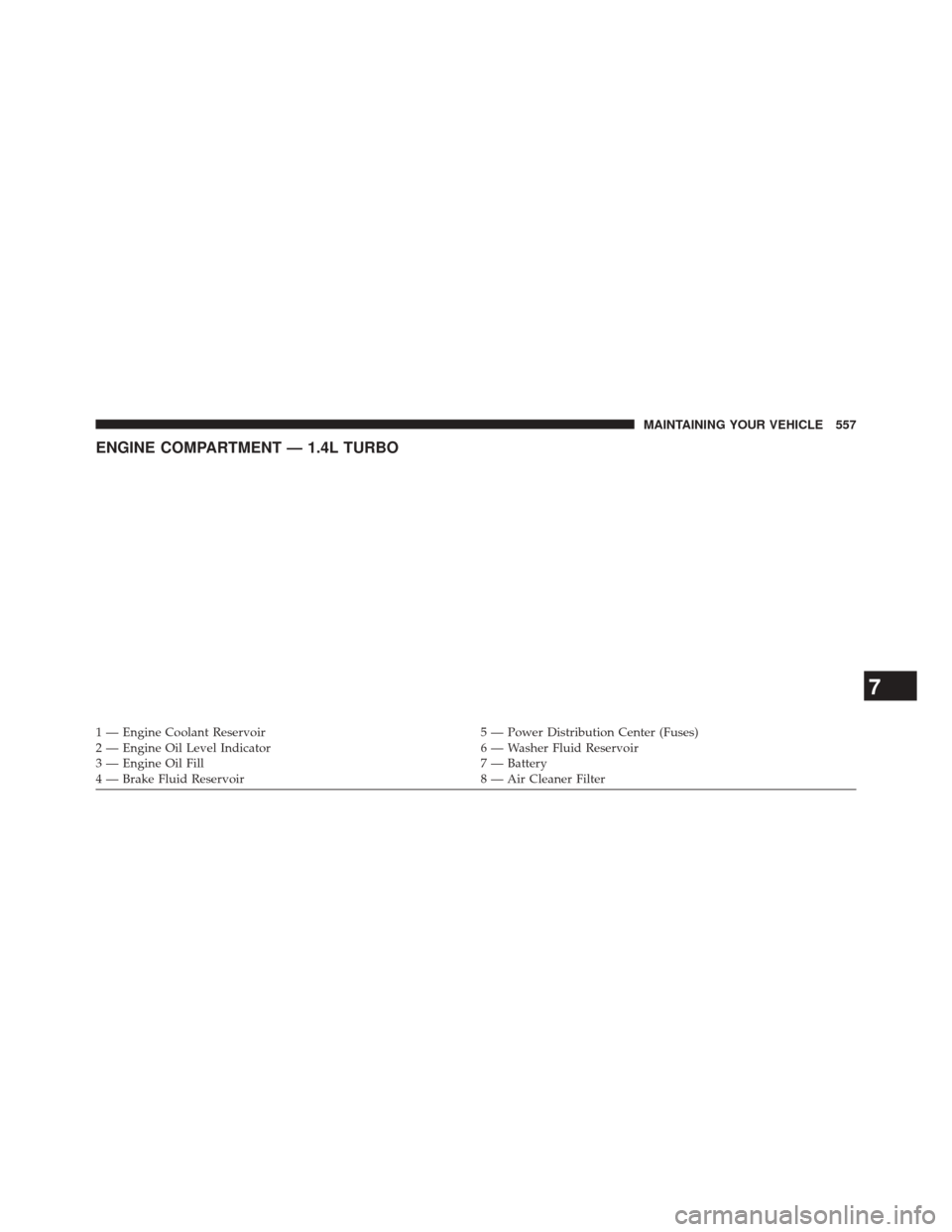
ENGINE COMPARTMENT — 1.4L TURBO
1 — Engine Coolant Reservoir5 — Power Distribution Center (Fuses)
2 — Engine Oil Level Indicator 6 — Washer Fluid Reservoir
3 — Engine Oil Fill 7 — Battery
4 — Brake Fluid Reservoir 8 — Air Cleaner Filter
7
MAINTAINING YOUR VEHICLE 557
Page 560 of 656
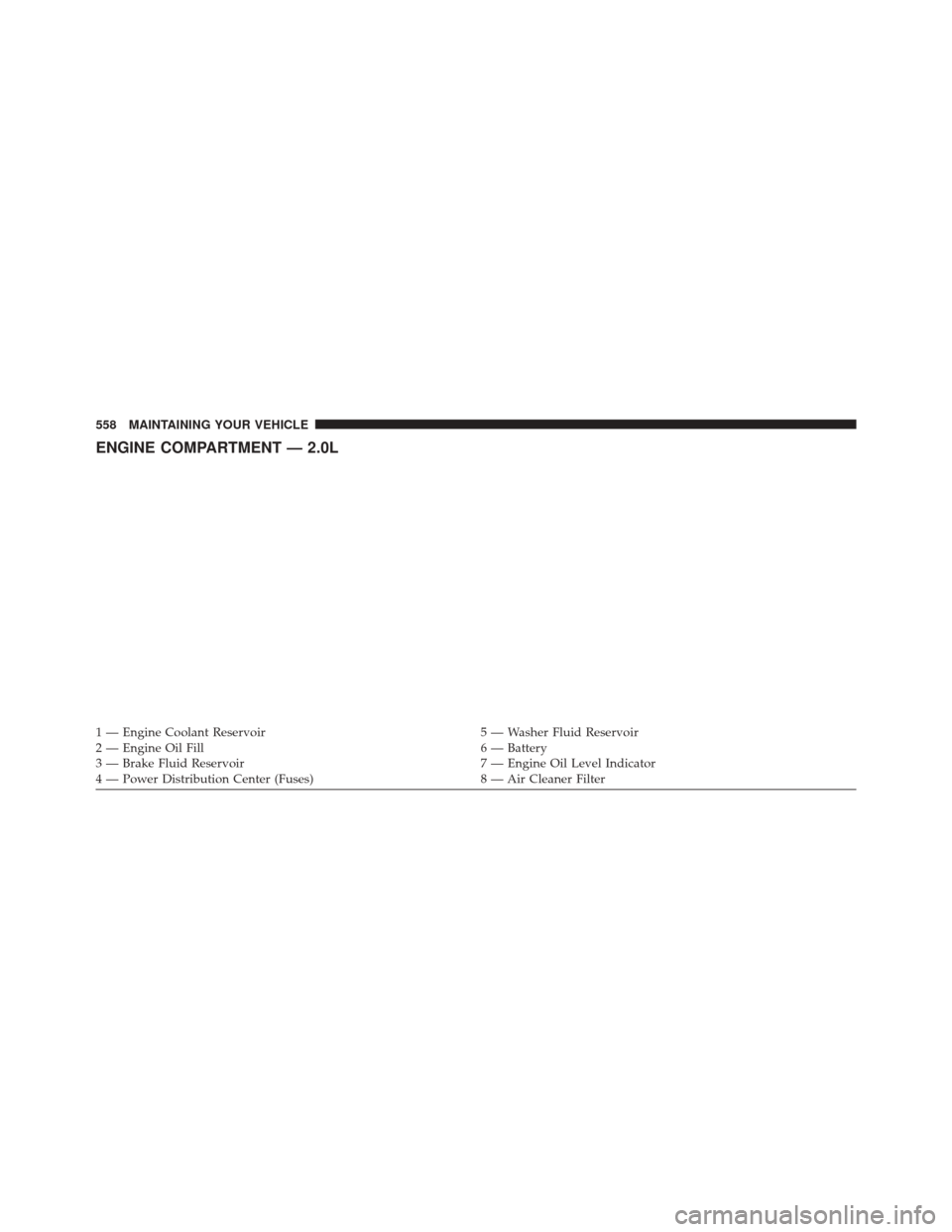
ENGINE COMPARTMENT — 2.0L
1 — Engine Coolant Reservoir5 — Washer Fluid Reservoir
2 — Engine Oil Fill 6 — Battery
3 — Brake Fluid Reservoir 7 — Engine Oil Level Indicator
4 — Power Distribution Center (Fuses) 8 — Air Cleaner Filter
558 MAINTAINING YOUR VEHICLE
Page 561 of 656
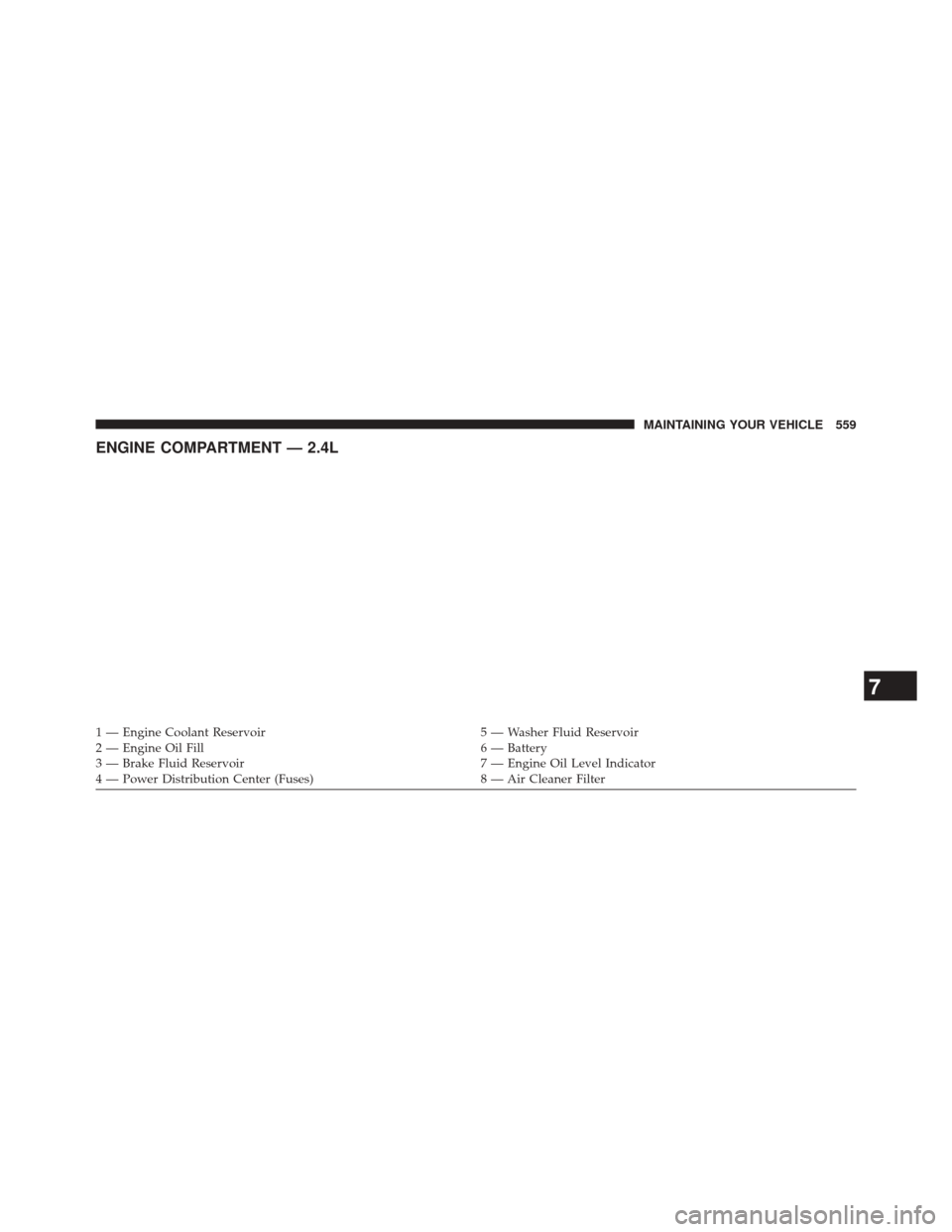
ENGINE COMPARTMENT — 2.4L
1 — Engine Coolant Reservoir5 — Washer Fluid Reservoir
2 — Engine Oil Fill 6 — Battery
3 — Brake Fluid Reservoir 7 — Engine Oil Level Indicator
4 — Power Distribution Center (Fuses) 8 — Air Cleaner Filter
7
MAINTAINING YOUR VEHICLE 559
Page 582 of 656
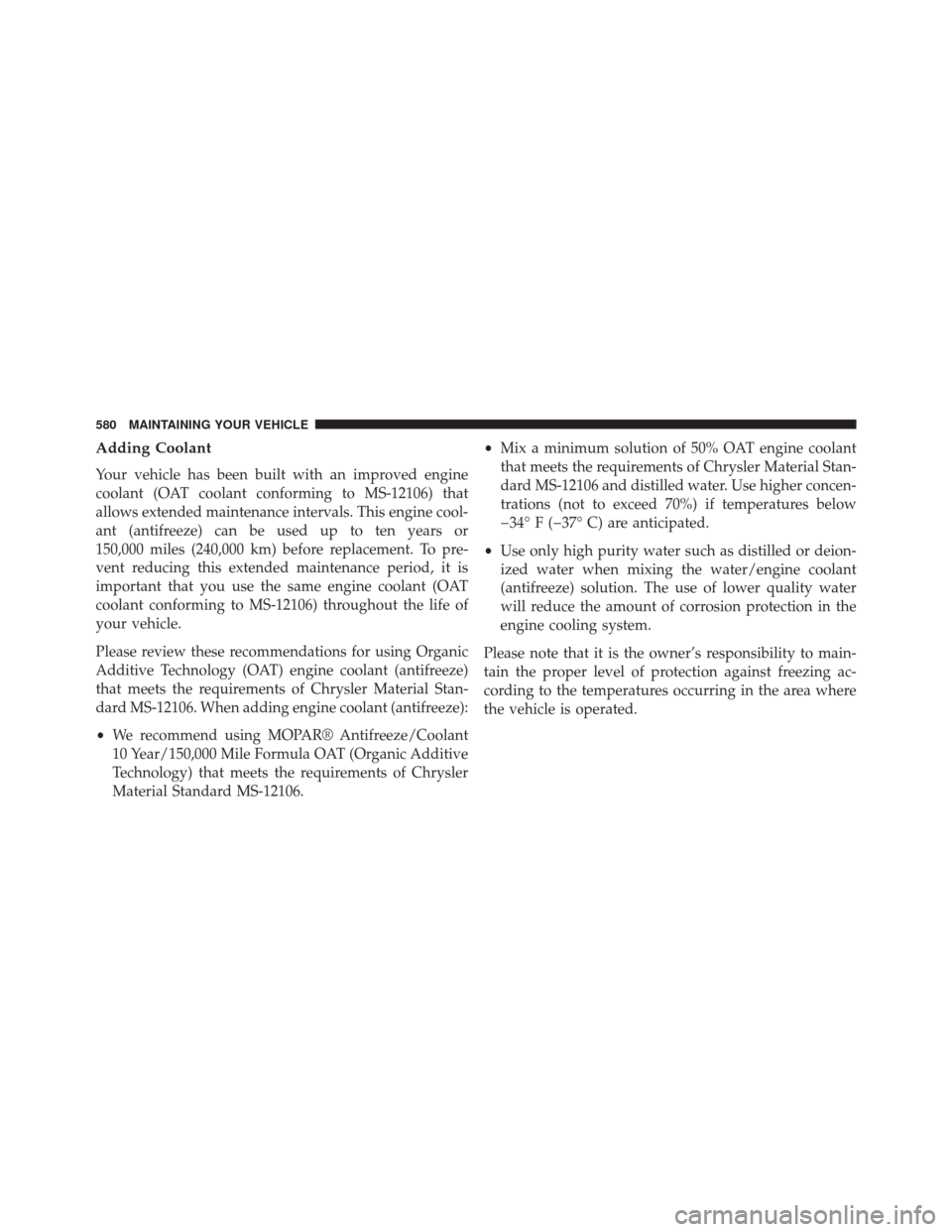
Adding Coolant
Your vehicle has been built with an improved engine
coolant (OAT coolant conforming to MS-12106) that
allows extended maintenance intervals. This engine cool-
ant (antifreeze) can be used up to ten years or
150,000 miles (240,000 km) before replacement. To pre-
vent reducing this extended maintenance period, it is
important that you use the same engine coolant (OAT
coolant conforming to MS-12106) throughout the life of
your vehicle.
Please review these recommendations for using Organic
Additive Technology (OAT) engine coolant (antifreeze)
that meets the requirements of Chrysler Material Stan-
dard MS-12106. When adding engine coolant (antifreeze):
•We recommend using MOPAR® Antifreeze/Coolant
10 Year/150,000 Mile Formula OAT (Organic Additive
Technology) that meets the requirements of Chrysler
Material Standard MS-12106. •
Mix a minimum solution of 50% OAT engine coolant
that meets the requirements of Chrysler Material Stan-
dard MS-12106 and distilled water. Use higher concen-
trations (not to exceed 70%) if temperatures below
�34° F (�37° C) are anticipated.
• Use only high purity water such as distilled or deion-
ized water when mixing the water/engine coolant
(antifreeze) solution. The use of lower quality water
will reduce the amount of corrosion protection in the
engine cooling system.
Please note that it is the owner’s responsibility to main-
tain the proper level of protection against freezing ac-
cording to the temperatures occurring in the area where
the vehicle is operated.
580 MAINTAINING YOUR VEHICLE
Page 584 of 656
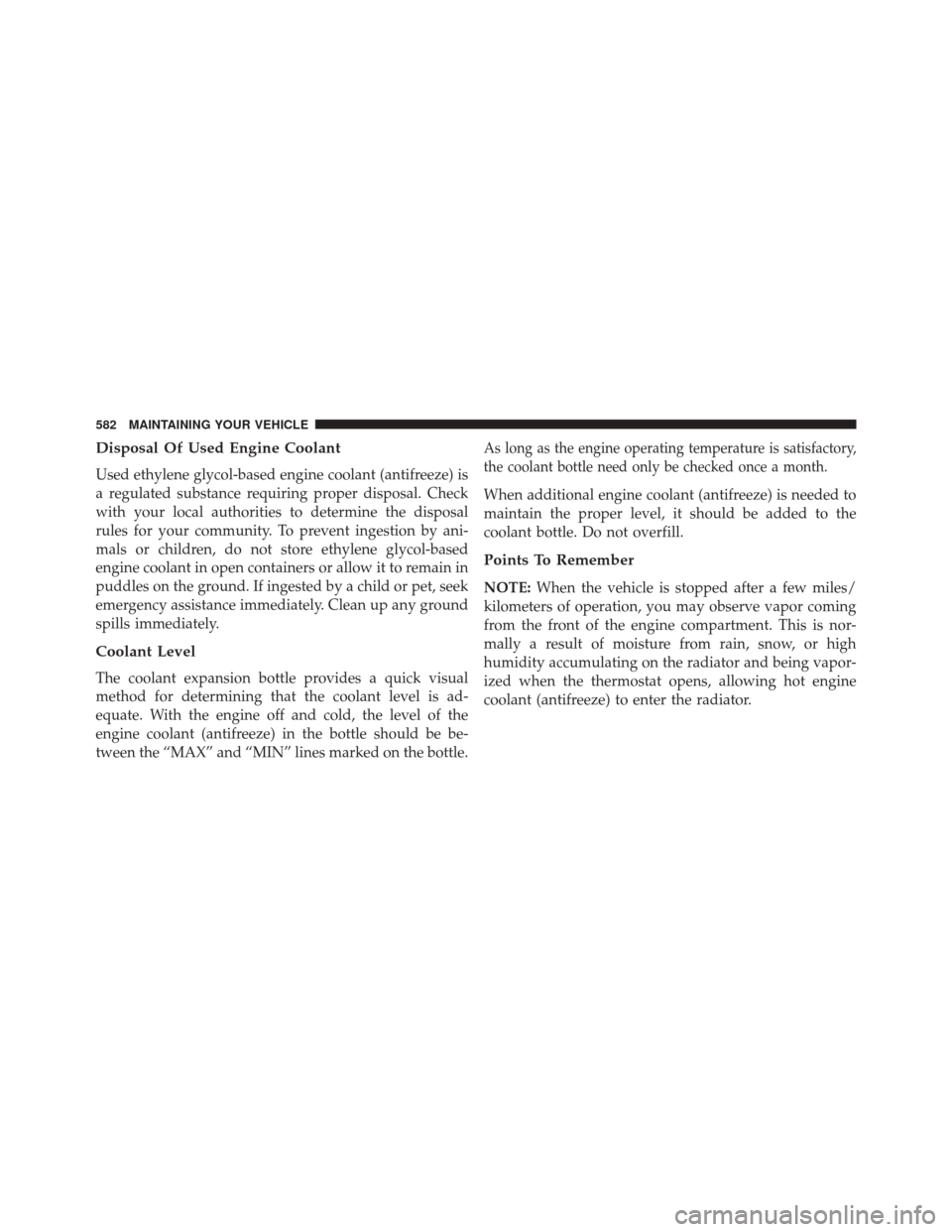
Disposal Of Used Engine Coolant
Used ethylene glycol-based engine coolant (antifreeze) is
a regulated substance requiring proper disposal. Check
with your local authorities to determine the disposal
rules for your community. To prevent ingestion by ani-
mals or children, do not store ethylene glycol-based
engine coolant in open containers or allow it to remain in
puddles on the ground. If ingested by a child or pet, seek
emergency assistance immediately. Clean up any ground
spills immediately.
Coolant Level
The coolant expansion bottle provides a quick visual
method for determining that the coolant level is ad-
equate. With the engine off and cold, the level of the
engine coolant (antifreeze) in the bottle should be be-
tween the “MAX” and “MIN” lines marked on the bottle.
As long as the engine operating temperature is satisfactory,
the coolant bottle need only be checked once a month.
When additional engine coolant (antifreeze) is needed to
maintain the proper level, it should be added to the
coolant bottle. Do not overfill.
Points To Remember
NOTE:When the vehicle is stopped after a few miles/
kilometers of operation, you may observe vapor coming
from the front of the engine compartment. This is nor-
mally a result of moisture from rain, snow, or high
humidity accumulating on the radiator and being vapor-
ized when the thermostat opens, allowing hot engine
coolant (antifreeze) to enter the radiator.
582 MAINTAINING YOUR VEHICLE
Page 610 of 656
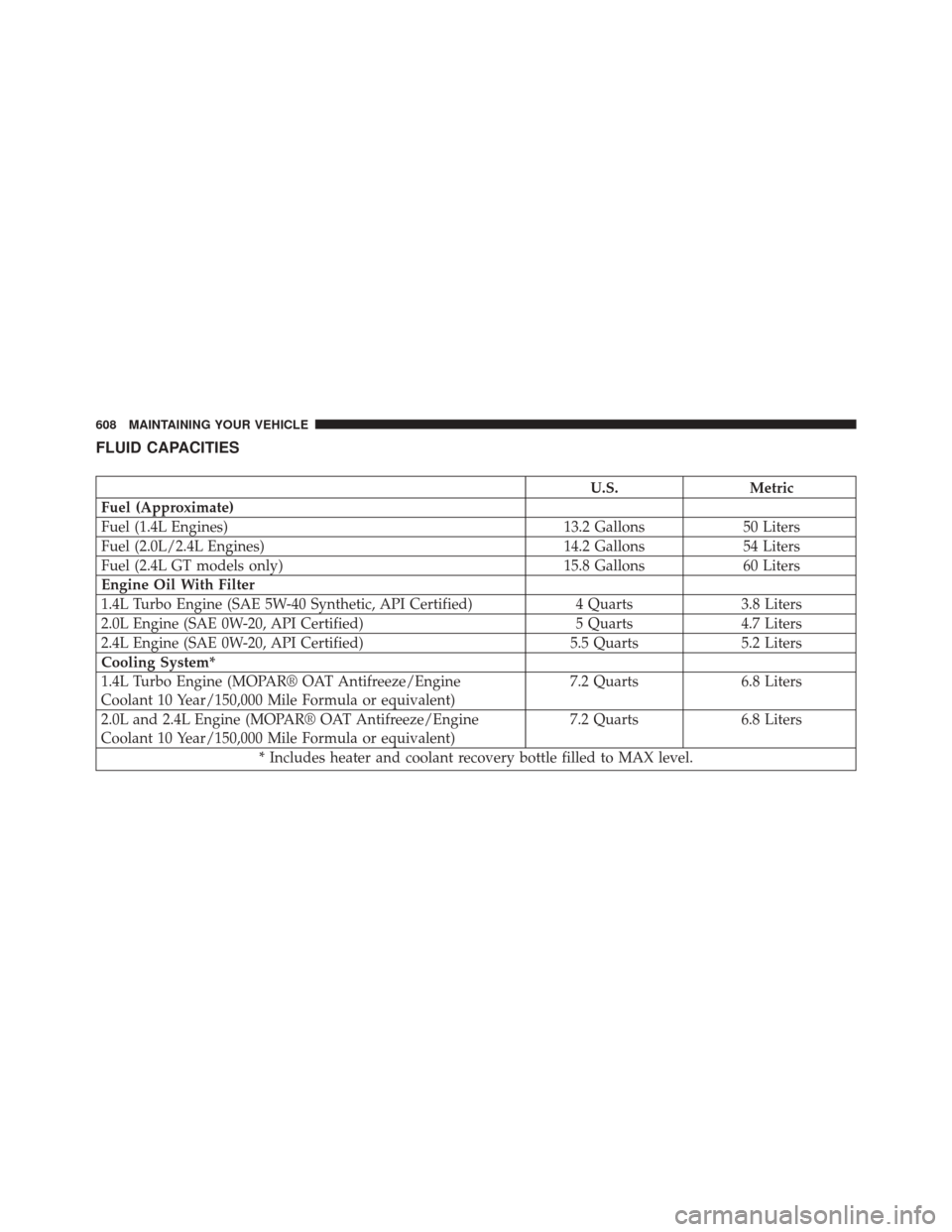
FLUID CAPACITIES
U.S.Metric
Fuel (Approximate)
Fuel (1.4L Engines) 13.2 Gallons50 Liters
Fuel (2.0L/2.4L Engines) 14.2 Gallons54 Liters
Fuel (2.4L GT models only) 15.8 Gallons60 Liters
Engine Oil With Filter
1.4L Turbo Engine (SAE 5W-40 Synthetic, API Certified) 4 Quarts3.8 Liters
2.0L Engine (SAE 0W-20, API Certified) 5 Quarts4.7 Liters
2.4L Engine (SAE 0W-20, API Certified) 5.5 Quarts5.2 Liters
Cooling System*
1.4L Turbo Engine (MOPAR® OAT Antifreeze/Engine
Coolant 10 Year/150,000 Mile Formula or equivalent) 7.2 Quarts
6.8 Liters
2.0L and 2.4L Engine (MOPAR® OAT Antifreeze/Engine
Coolant 10 Year/150,000 Mile Formula or equivalent) 7.2 Quarts
6.8 Liters
* Includes heater and coolant recovery bottle filled to MAX level.
608 MAINTAINING YOUR VEHICLE
Page 616 of 656
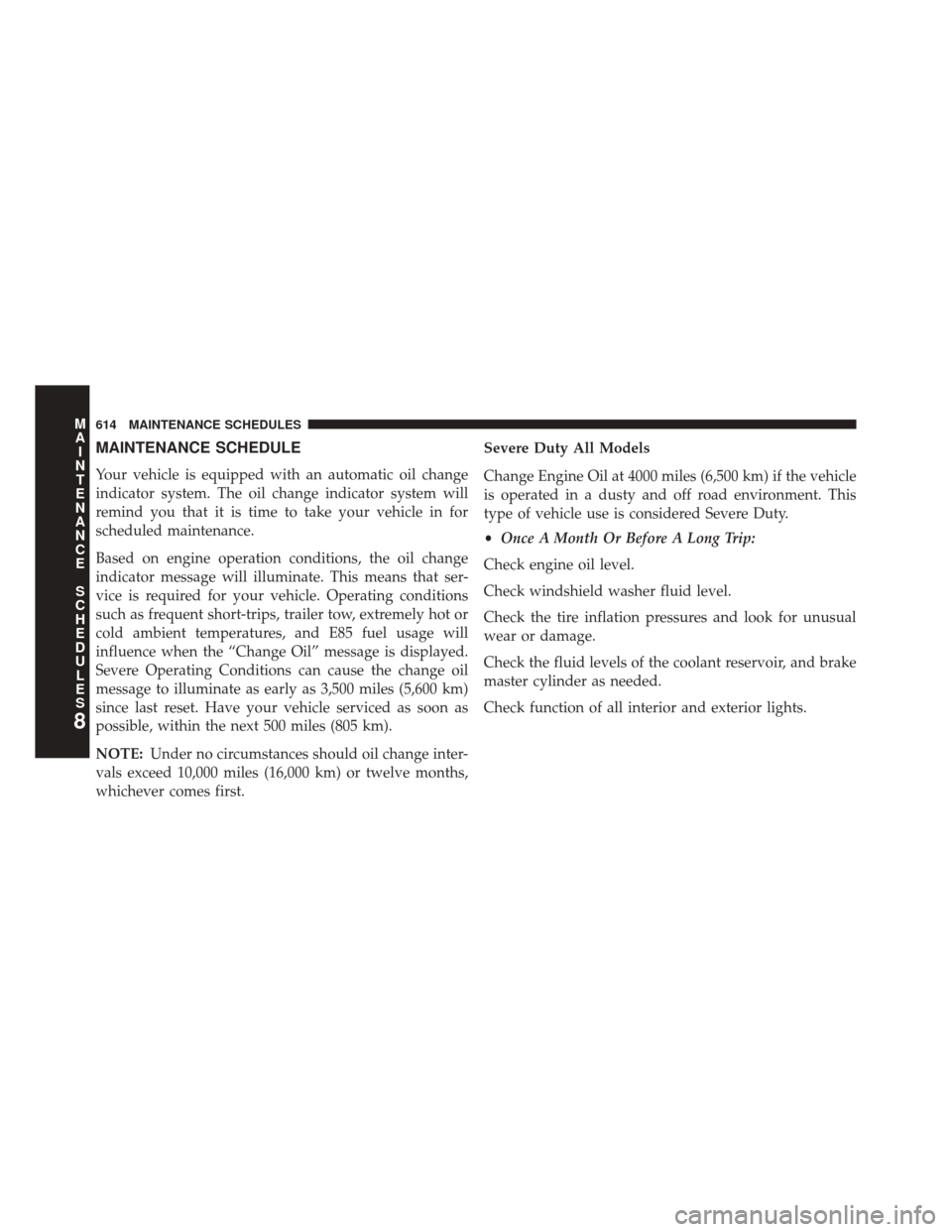
MAINTENANCE SCHEDULE
Your vehicle is equipped with an automatic oil change
indicator system. The oil change indicator system will
remind you that it is time to take your vehicle in for
scheduled maintenance.
Based on engine operation conditions, the oil change
indicator message will illuminate. This means that ser-
vice is required for your vehicle. Operating conditions
such as frequent short-trips, trailer tow, extremely hot or
cold ambient temperatures, and E85 fuel usage will
influence when the “Change Oil” message is displayed.
Severe Operating Conditions can cause the change oil
message to illuminate as early as 3,500 miles (5,600 km)
since last reset. Have your vehicle serviced as soon as
possible, within the next 500 miles (805 km).
NOTE:Under no circumstances should oil change inter-
vals exceed 10,000 miles (16,000 km) or twelve months,
whichever comes first. Severe Duty All Models
Change Engine Oil at 4000 miles (6,500 km) if the vehicle
is operated in a dusty and off road environment. This
type of vehicle use is considered Severe Duty.
•
Once A Month Or Before A Long Trip:
Check engine oil level.
Check windshield washer fluid level.
Check the tire inflation pressures and look for unusual
wear or damage.
Check the fluid levels of the coolant reservoir, and brake
master cylinder as needed.
Check function of all interior and exterior lights.
8
M A I
N T
E
N
A
N
C E
S
C
H E
D
U L
E
S614 MAINTENANCE SCHEDULES
Page 637 of 656
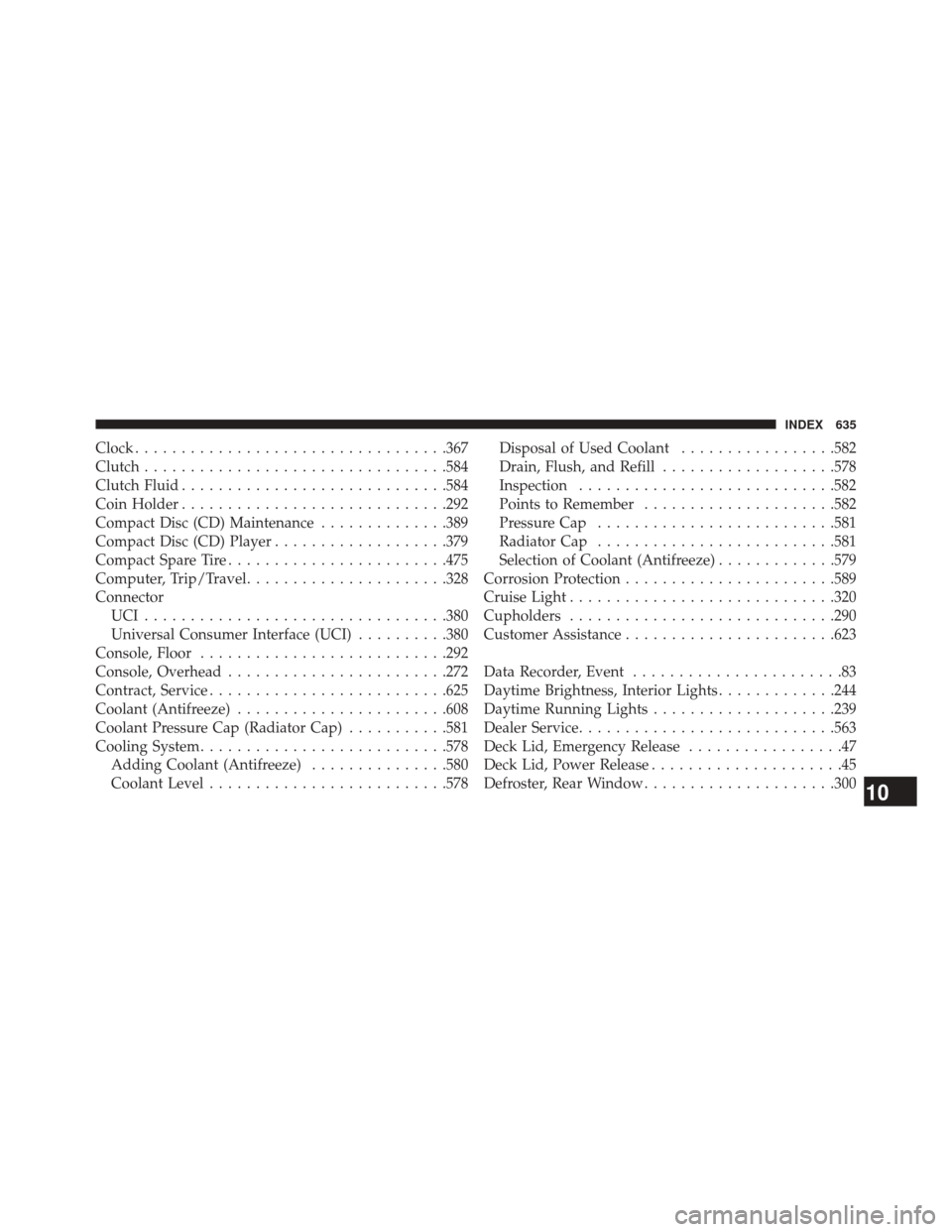
Clock................................. .367
Clutch .................................584
Clutch Fluid ............................ .584
Coin Holder ............................ .292
Compact Disc (CD) Maintenance ..............389
Compact Disc (CD) Player ...................379
Compact Spare Tire ........................475
Computer, Trip/Travel ..................... .328
Connector UCI................................ .380
Universal Consumer Interface (UCI) ..........380
Console, Floor .......................... .292
Console, Overhead ........................272
Contract, Service ..........................625
Coolant (Antifreeze) .......................608
Coolant Pressure Cap (Radiator Cap) ...........581
Cooling System .......................... .578
Adding Coolant (Antifreeze) ...............580
Coolant Level ..........................578 Disposal of Used Coolant
.................582
Drain, Flush, and Refill ...................578
Inspection ............................582
Points to Remember .....................582
Pressure Cap ..........................581
Radiator Cap ..........................581
Selection of Coolant (Antifreeze) .............579
Corrosion Protection .......................589
Cruise Light ............................ .320
Cupholders ............................ .290
Customer Assistance .......................623
Data Recorder, Event .......................83
Daytime Brightness, Interior Lights .............244
Daytime Running Lights ....................239
Dealer Service ............................563
Deck Lid, Emergency Release .................47
Deck Lid, Power Release .....................45
Defr oster
, Rear Window .....................300
10
INDEX 635